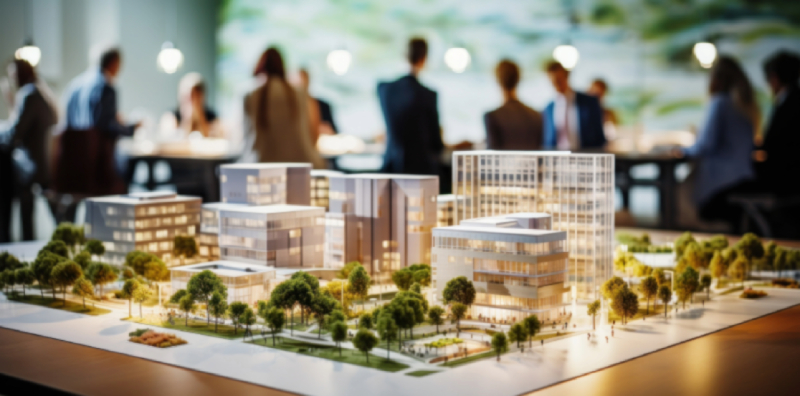Commercial architects play a pivotal role in shaping the skylines of cities and the spaces in which we work, shop, and socialize. Their work requires a keen eye for commercial building design and a profound understanding of functionality, sustainability, and the socio-economic environment. This blog explores the multifaceted role of commercial architects by looking into their daily activities, collaboration with clients, project management strategies, and the latest innovations in commercial architecture design techniques.
A Day in the Life of a Commercial Architect
The day-to-day life of a commercial architect is busy and challenging, reflecting the complexity and scale of the projects they undertake. A typical day might start with a review of architectural drawings, schematics, and other project plans to ensure every architectural design detail aligns with the aesthetic and functional necessities of every commercial building in the works.
Meetings are a staple—whether with project teams to coordinate efforts or with civil engineers and contractors to discuss the feasibility of designs or troubleshoot issues.
Midday might involve site visits to ongoing projects, allowing architects to oversee construction, verify design implementation, and make real-time decisions. The afternoon could be dedicated to sketching new concepts or refining existing designs using advanced architectural software, preparing presentations, or responding to client feedback.
Every project has a unique budget and design development that determines the milestones. The days can be long, but completing a stunning project that benefits the community is worth it.
How Commercial Architects Collaborate with Clients
Effective collaboration with clients is crucial in commercial architecture. Architects must fully understand their client’s vision, business objectives, and budget constraints. This collaborative process often involves numerous discussions, presentations, detailed drawings, and revisions of all of these elements at various stages of the building process.
Client relationships are often long-term, extending beyond a single project. A successful partnership can lead to further contracts, which benefits both parties. Thus, communication skills, empathy, and flexibility are as important as technical expertise in the life of a commercial architect.
At Fuse, we work closely with and actively engage with all our clients to ensure that the final design meets expectations while remaining functional and financially viable. Our goal is to make your dream a reality.
Project Management in Commercial Architecture
Project management is another critical aspect of a commercial architect’s role. They must juggle diverse elements such as project timelines, budgets, building and zoning codes, safety regulations, and team coordination. Architects often take on the role of project leaders, liaising with construction managers, engineers, designers, and clients to keep the project on track, even with the occasional setback.
Risk management is also integral to project management. This includes anticipating potential design and construction challenges and devising strategies to mitigate these risks. Efficiency, foresight, and strategic planning are essential skills that help an architect manage large-scale projects effectively.
Innovations in Design Techniques
Commercial architecture is continually evolving with advancements in technology and materials. Innovative design techniques such as Building Information Modeling (BIM) and AI tools allow architects to create more accurate models and simulations, making it easier and more efficient to present detailed specifications to improve collaboration among various stakeholders.
Sustainability is at the forefront of our architectural innovation. Modern commercial architects, including our team at Fuse Architecture Studio, strive to integrate eco-friendly materials and energy-efficient designs. Techniques like passive solar design, green roofing, and using sustainable materials are becoming commonplace, reflecting a shift towards more environmentally conscious design philosophies.
Types of Commercial Buildings
Commercial buildings are structures specifically designed to host commercial activities. These buildings are central to the economic health of cities and regions, offering spaces for businesses and professionals to operate. Here’s a more detailed look at different aspects of commercial buildings:
- Office Buildings: These can range from small professional offices to towering skyscrapers in a city’s financial district. They’re designed to provide a productive environment for businesses.
- Retail Spaces: These facilities are tailored to enhance consumer experience and sales.
- Warehouses and Industrial Buildings: These are primarily used for storage and distribution of products but can also include manufacturing facilities and chemical storage.
- Mixed-Use Developments: Combining residential, business, and leisure, these buildings are designed to facilitate a multifunctional environment.
In addition to pioneering the commercial construction process in Austin and abroad, Fuse delivers educational architecture services to local schools, universities, and other educational facilities, as well as technology and industrial architectural services to high-tech building projects needing renovation or structural addition.
Key Considerations in Commercial Projects
- Location: Proximity to target markets, accessibility, and local zoning laws are critical.
- Design: Must meet the specific needs of the businesses operating within the space while being visually appealing.
- Sustainability: Increasingly, projects are expected to incorporate sustainable building practices and materials.
- Technology: Modern commercial buildings often feature advanced technology for improved functionality, safety and efficiency.
- Regulatory Compliance: Adhering to local and Federal building codes and regulations is essential for legal and safety reasons.
Features of Commercial Buildings
- Accessibility: Essential for employees and customers, particularly those with disabilities.
- Technology Integration: Modern commercial buildings often incorporate advanced security, communication, and operations management technology.
- Energy Efficiency: Given their size and operational demands, these buildings are increasingly designed with sustainability techniques, utilizing energy-efficient systems and sustainable materials.
- Safety and Security: Commercial buildings have fire safety systems, emergency exits, security cameras, and sometimes even biometric security systems.
The Importance of Design in Commercial Buildings
The design of commercial buildings significantly impacts their functionality and the businesses they host. Good design can improve efficiency, employee satisfaction, and customer retention. Architects play a crucial role in ensuring that these structures meet aesthetic standards and are practical, safe, and sustainable.
Overall, commercial buildings are vital infrastructures that support various economic activities, driving growth and development in their respective locales.
Trust Fuse Architecture Studio for Your Next Commercial Project
The role of a commercial architect is integral to the development of functional, aesthetically pleasing, and sustainable commercial spaces. Their daily routine reflects a blend of creative endeavor and meticulous planning. At the same time, their ability to manage projects and innovate in design keeps many commercial architects at the forefront of architectural progress.
Contact us if you have a challenging or innovative commercial construction project in mind. The project begins with your idea; we’re here to help you execute it!

